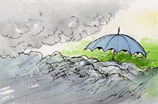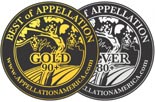
 The Columbia Valley AVA is Washington’s all-encompassing region with some 11 million acres of land in all. Included within its confines are six other American Viticultural Areas (AVA) including Yakima Valley, Red Mountain, Walla Walla Valley, Horse Heaven Hills, Rattlesnake Hills and Wahluke Slope. The Columbia Gorge and Puget Sound AVAs are the only appellations in Washington that fall outside of its borders. Despite the number of sub-appellations within its boundaries, there is the potential for further AVA development. The most significant places where the Columbia Valley is the primary appellation and does not overlap another AVA are the Royal Slope, the Columbia Basin, and the vast expanse north of the Rattlesnake Hills, which includes the entire region loosely called Columbia Cascade.
The Columbia Valley AVA is Washington’s all-encompassing region with some 11 million acres of land in all. Included within its confines are six other American Viticultural Areas (AVA) including Yakima Valley, Red Mountain, Walla Walla Valley, Horse Heaven Hills, Rattlesnake Hills and Wahluke Slope. The Columbia Gorge and Puget Sound AVAs are the only appellations in Washington that fall outside of its borders. Despite the number of sub-appellations within its boundaries, there is the potential for further AVA development. The most significant places where the Columbia Valley is the primary appellation and does not overlap another AVA are the Royal Slope, the Columbia Basin, and the vast expanse north of the Rattlesnake Hills, which includes the entire region loosely called Columbia Cascade.
Apart from its sheer size, the Columbia valley is also widely seen on wine labels because many of Washington’s best known wineries are located in the Seattle metropolitan area. These wineries transport grapes over from Eastern Washington to make their wines. The wines are invariably a blend of grapes sourced from various locales, and as a consequence are labeled using the large Columbia Valley AVA. Interestingly, Walla Walla, though an AVA unto itself as well as being home to almost 100 wineries, has very little vineyard. Most of its wines are also labeled Columbia Valley.
The Columbia Valley AVA is geographically defined by mountain ranges which border it on the west and north, and by the Columbia River on the south until it turns north at the Wallula Gap. Here the appellation continues east, following the state line and then dipping down into Oregon to include the southern part of the Walla Walla Valley AVA. The Columbia Valley’s eastern border is loosely defined by the land surrounding the Columbia River as it jogs north, and the Snake River as it runs east.
Any AVA this large will incorporate significant differences in rainfall, soils and climate, but in general the Columbia Valley may be characterized by the fact that it encompasses the Eastern Washington desert. Located in the lee of the Cascade Mountains, the bulk of Eastern Washington is sheltered from the marine climate of Western Washington. Where grapes cannot be grown in this part of the state, it is either too cold in the winter or there is insufficient water for irrigation; however, virtually all Columbia Valley vineyard land is irrigated.
~ Paul Gregutt
|
|
Current Feature
In the southern Blue Ridge Mountains of North Carolina and Georgia vineyards are small and few, yet the establishment of the Upper Hiwassee Highlands could bring much more.
[>] continue
Appellation Features
[>] see all Columbia Valley features (3)
Related Features
Best of Appellation
See the best wines of
Columbia Valley
BLUE BOOK PROFILES
Blue Book Taste Profiles for the Columbia Valley AVA
Alive & Well here

Merlot:
Madame Merlot, you’re a big gal, soft and smoky; how we love your full, curvaceous figure. But you are
[>] continue



 Bi-State Upper Hiwassee Highlands an AVA
Bi-State Upper Hiwassee Highlands an AVA  Long Shadows Vintners
Long Shadows Vintners  Washington's Columbia Cascade Region: An AVA in Waiting
Washington's Columbia Cascade Region: An AVA in Waiting  Welcome the Hero
Welcome the Hero Remote Manton Valley New California AVA
Remote Manton Valley New California AVA WAWGG Banquet Explores Washington State Terrior
WAWGG Banquet Explores Washington State Terrior Taking Focus on Appellation
Taking Focus on Appellation Whitehall Lane Winery, A 20 Year Story of Vineyards
Whitehall Lane Winery, A 20 Year Story of Vineyards Embracing Virginia’s Terroir
Embracing Virginia’s Terroir 




